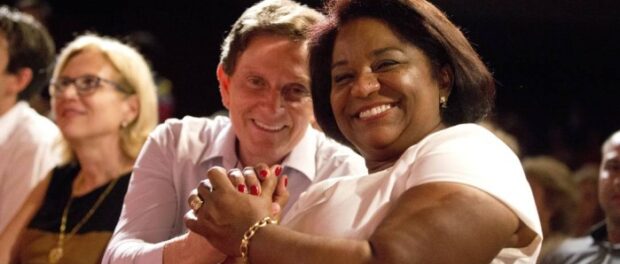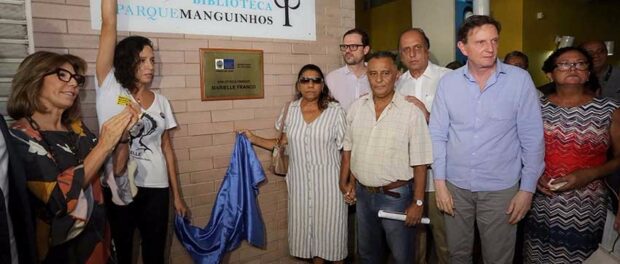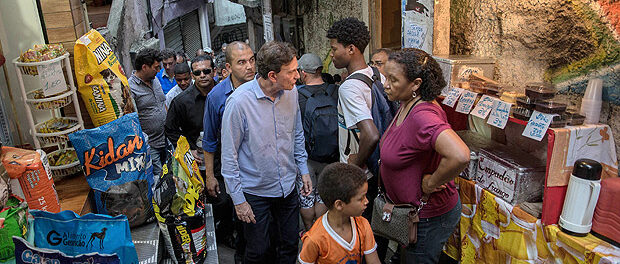
This is the first article in a two-part series monitoring and critiquing Rio Mayor Marcelo Crivella during his time in office thus far, and covering policies related to culture, public security, and urban and social interventions. See the second article here.
Rio de Janeiro Mayor Marcelo Crivella has had a tenure marked by absences. By mid-February of this year, he had spent at least 36 days out of the city. He was not only absent during Carnival, during which the mayor usually plays a symbolic role, but he was “following from a distance” when torrential rains in Rio killed four people and displaced more than 2,000. He was also not in the city at the moment when the federal military intervention was announced.
Beyond his physical departures from the city, he has also been absent in terms of his silence and undelivered policies. The city’s Strategic Plan, which should have been revised by his team in 2017 following the engagement of and suggestions by civil society, was never submitted. It has been shelved. Meanwhile, then Sub-Secretary for Planning and Governmental Management, Aspásia Camargo, who spearheaded the Plan, was reassigned to Innovation at the Chief of Staff’s Office, and the sub-secretary position was renamed as the Sub-Secretary for Planning and Results Monitoring. It remains to be seen what results will be monitored.
If we compare this with the process of consultation for São Paulo’s Strategic Plan (where it is called the Plano de Metas, or Objectives Plan)–a city with dimensions and challenges comparable to those of Rio de Janeiro–we can see what the City of Rio might have achieved under different circumstances. São Paulo’s city government delivered the final version of its plan in July 2017 after public consultation, and created a website monitoring various indicators of the goals to allow citizens to assess its progress.
With this background, let’s take stock of the actions and inactions that characterize the first 15 months of Crivella’s administration:
“We will not have culture” in favelas
In the realm of culture, the Strategic Plan does not provide for initiatives to foster cultural projects. Existing funds to promote culture were either suspended or redirected to other areas, and funds for new calls for cultural proposals were fewer and offered less resources than in the past. The only provision was for the program Vale Cultura, which Crivella promised in his campaign platform to expand, such that at least 1% of the municipal budget would be dedicated to the promotion of culture in the city for Crivella’s first year in office. However, this provision went unfulfilled.
For Crivella, art and culture do not need to be remunerated, and therefore, do not require investments. When he created the project “Rio Big Walls” to revitalize urban spaces through graffiti, Crivella declared: “We are going to be praised and this has cost City Hall absolutely nothing. Look how interesting it is, we’re talking so much about the city government’s patronage and here is a beautiful partnership, forged by a young idealist, along with a producer, as a free gift to the city.”
Under Crivella’s leadership, the city has witnessed cuts in funds for Carnival, the Casa do Jongo (which even resulted in temporary closure), and resources designated for the New Blacks Institute, Rio’s slave cemetery and one of few institutions charged with public education about Rio’s past as the world’s largest slave port. It is hard to imagine that it is a coincidence that the three are all strongly associated with black culture, especially in the context of the growing intolerance of some sectors of the Evangelical Church towards black culture and religions with African roots. The optimism that accompanied the nomination of Nilcemar Nogueira, a black women from the periphery and the granddaughter of the samba musician Cartola, as the Municipal Secretary of Culture was soon extinguished when it became obvious that her agenda was no different from that of Mayor Crivella, and that her policies valued only the Museum of Tomorrow as a cultural site.
In the same vein, although it was included in the Strategic Plan and officially established by decree in May 2017, the Slavery and Freedom Museum is still no more than an idea on paper. Moreover, there was no follow-up as to whether or not its controversial name would be subject to public consultation as was promised. In favelas, the Park Libraries of Rocinha and Manguinhos only reopened several months late as the City missed multiple of its own deadlines. The Park Library of Alemão has been occupied since January 2017 by Military Police (who occupy the abandoned cable car station where the library is located) and remains closed. In September of last year, the government announced plans for the creation of a Knowledge Ship in Rocinha, but so far no more has been said on the subject. Crivella also promised in his election campaign to invest in cultural centers, yet another pledge which remains unmet.
The Strategic Plan discusses the revitalization of existing cultural centers and libraries, but provides neither for the creation of new cultural spaces in areas that lack them, nor for funds to support the implementation of cultural activities in existing spaces. Rather, the mayor stated that cultural activities should take place in school spaces.
Beyond this, the production of cultural events in favelas is increasingly difficult, especially given the creation of a bureaucratic office linked to City Hall which has increased the number of licenses needed in order to host an event on the street. It is now possible to reject or cancel a license even as the event takes place. Thus, we can see an effort on the part of government to realize the prophecy of Crivella’s then Sub-Secretary of Planning who said “we will not have culture” in favelas. But this top-down effort is resisted daily by people like Daiana Oliveira, of Ballet Manguinhos, who took it upon herself to run the Manguinhos library space while it was officially closed.
“We will never be absent (from public security)”
At his inauguration Crivella affirmed that “the question of Public Security, we know, is the responsibility of the State, not the City. However, we will never be absent.” Indeed, the municipal government has little to do with public security, since it has traditionally been under the domain of the state government and now falls under the national government due the federal military intervention. The intervention places the State Security Secretariat under the control of the intervener, General Walter Braga Netto. Still, the mayor felt inclined to voice his position on the intervention; in contrast to the Chamber of Deputies, Rio de Janeiro’s chapter of the Brazilian Bar Association, and several civil society and academic organizations, which advocated for monitoring and setting limits on the military intervention, Crivella argued: It is “impossible to conduct an operation in a poor community without a certain level of violence,” a discourse that contributes to the legitimization and naturalization of this very violence.
In addition, his response to the grave situation in Rocinha in late 2017 was slow—it took him 15 hours after the conflict arose to speak about the incident via an official notice, which read:
It is with great sadness that the mayor of Rio de Janeiro, Marcelo Crivella, is following the situation of fear and insecurity provoked by drug traffickers, this Friday the 22nd, in Rocinha, in São Conrado in the South Zone. Crivella stands in solidarity with the residents who live in the area and are experiencing extremely difficult days… Although it is a responsibility of the state government, the City of Rio will not fail to help in any way it can to combat this violence in the city… The mayor believes that, with everyone’s cooperation, Rio will win this battle.
In the narrative produced by the city government and likewise by the mainstream media, the fear is caused by drug traffickers and Rio is living through “battle” conditions, which justifies the necessity of deploying federal troops.
In areas where the mayor could play a more active role regarding public security, Crivella’s policies have served to benefit the city’s most privileged areas, aiming to reduce the occurrence of crimes “in the city’s beachfront areas” as delineated in the Strategic Plan. The City created the program “Rio+Seguro” (Rio, More Secure), which increased the presence of the Municipal Guard and promoted the use of technologies such as cameras in the beachfront neighborhoods of Copacabana and Leme. The administration renewed the “Presente” (Present) program in Centro through mid-2018, in partnership with Fecomércio which has also guaranteed the continuation of the program in Méier, Lagoa, and the Aterro do Flamengo until at least the end of 2018. Furthermore, the government has given motorcycles to the Municipal Guard, adding the role of urban patrol to the unit’s responsibilities (in addition to the protection of property, the Municipal Guard can police “preventatively”). The same unit has now been placed at the disposal of federal security forces in order “to attack drug sales points,” according to Crivella. The mayor was also caught up in a controversy after the City distributed a questionnaire to survey the Guards’ religious affiliations, which only had options for “Catholic,” “Evangelical,” “Spiritist,” and “Other.”
Other controversies have included the proposal, following the death of the young Maria Eduarda, that municipal school walls should be reinforced with bulletproof mortar—an action that was supposed to be implemented in April of last year but never occurred. Another incident arose when the mayor declared that, although security was not his priority, he had been seeking modern technologies to combat violence during his trip to Europe, the reason for his absence during the torrential rains in February. This claim was contested by the German agency he visited, which reported that his visit was of a personal nature.
Click here for Part 2.
This is the first article in a two-part series monitoring and critiquing Rio Mayor Marcelo Crivella during his time in office thus far, and covering policies related to culture, public security, and urban and social interventions. See the second article on urban and social interventions here.



